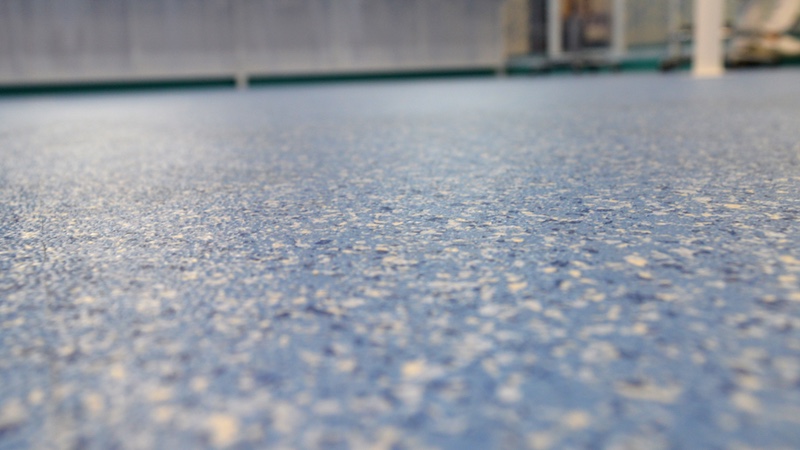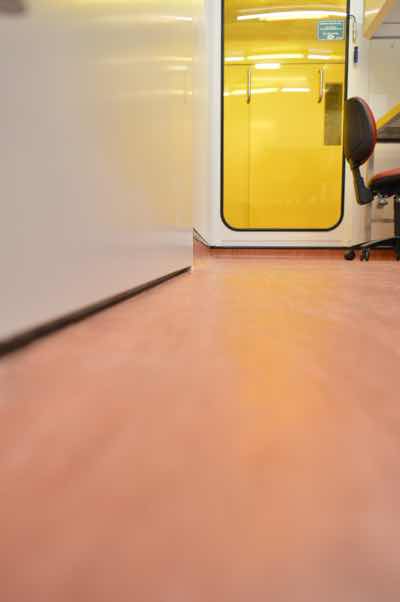Flooring can be at the bottom of the ladder when planning a new cleanroom. As contamination has a downward flow it is an element not often given as much consideration as those featuring higher in the cleanroom; wall construction, for example. But, a non-cleanroom compliant floor could introduce and harbour contamination to the environment thus putting manufacturing processes at risk.
“The choices and the technology out there in the market are growing,” says Rebecca Smith, national territories manager at Connect 2 Cleanrooms. Smith believes it is important to consider flooring right at the beginning of the cleanroom planning stage, so the correct type is selected. She points out that considerations including GMP requirements, the existing flooring, process compatibility, cleaning protocol and cleanroom type will drive the selection decision.
There are two main cleanroom flooring options, namely loose lay flooring and vinyl flooring. Each has many variants, bringing its own benefits and opportunities. Smith comments: “Both types are available in multiple colours, meaning areas can be colour coded to signal separate zones within the cleanroom, or pathways can be created to signpost operatives.”
Modular Floor
Loose lay or jigsaw flooring provides an easy to clean, modular cleanroom floor, which is none shedding.

“The modular nature of the floor allows flooring to be easily extended or relocated as the facility expands,” Smith explains, noting that there is minimum prep work required as it can be installed directly onto most floors. For this reason, she says, it is the perfect renovation or upgrade floor for many.
The simplicity and durability of jigsaw flooring make it suitable for ISO Class 7/8 cleanrooms in both engineering and manufacturing environments. Typically, these are hardwall or softwall modular cleanrooms so a modular floor is a good fit. It also allows for future expansion.
“Models such as the Gerflor GTI Max Decor Jigsaw floor has a very high resistance to traffic and, with a considerable load capacity of up to 120 kg per cm2, damage to a tile is unlikely,” she observes. “If a tile does get damaged, there is no lengthy shutdown period whilst a new floor is laid as tiles can be replaced within seconds.”
Smith says this model can also be upgraded to ESD flooring by laying a conductive copper grid below the tiles, for applications where sensitivity to static charges is a concern. She explains: “Some processes, such as composite manufacture for aerospace, have outgassing issues that can affect sensitivities of product. With loose lay jigsaw flooring, there is no adhesive required, reducing the risk of damage to sensitive components, which could be affected by outgassing. It can even be retro-fitted to existing controlled environments with ease.”
Vinyl Flooring
Vinyl flooring can provide a smooth, flush finish to the cleanroom environment and is often coved into corners to create a seamless joint with the wall construction. This leaves no cracks or crevices for the accumulation of particulate contamination.

“Consider a cross-linked and UV cured PU, as the polymers will be more closely bonded together, creating a more durable and scratch resistant materials,” Smith suggests as a scratch in flooring could release particles into the environment, creating process risk. “The more durable and hardwearing the floor is, the lower the risk of contamination, which is why crosslinking and UV curing is so important,” she says.
Smith points out that Polyflor’s Classic Mystique PUR flooring is a flexible PVC sheet and tile flooring in 2 mm thickness and has a BRE Global A+ rating ENP 472 in major use areas such as education and healthcare environments. She explains: “It balances health and safety requirements with process control, as it is fully tested to EN 13501-1 in respect of flame spread and has a slip resistance, classified in dry conditions (DS) to EN 13893.”
For large scale applications, expansion joints can help vinyl flooring interface with the existing facility. “These joints are rubber concertinas protecting the flooring during heat expansion and contraction depending on the movement of the building,” Smith says. These give a level of flexibility if the building has movement due to atmospheric conditions.
Connect 2 Cleanrooms delivered such solution to ConvaTec, the global medical product and technology company. Smith explains: “Prior to this flooring installation a chemical damp proof course was applied to prevent moisture build up underneath the floor. This preparation increases the longevity of the flooring, as the risk of damage over time is significantly reduced, protecting against potential down time.”
Coving
A coved finish to flooring creates a smooth and easy to clean system; one of the hallmarks of GMP design. Usually coved onto panel system cleanrooms, this makes it the preferred choice for healthcare and medical cleanrooms.
“Coved floors are also watertight and durable. Gerflor has a patent pending Coved Corner System, which gives rounded corner,” Smith says. “This system gives a smoother finish with less welds, making them less likely to collect dust. It also gives them additional strength and durability that will withstand traffic.” Smith also points out that vinyl tiles with a copper grid are available to create ESD flooring. These can be used in semiconductor or static sensitive environments.
Bunded Flooring
“Organisations looking to contain liquids in a manufacturing environment should consider bunded flooring,” Smith says. Her team, for exampe, provided a bunded floor for a client who was housing a 5,000-gallon vessel of a hazardous solution. “If the vessel failed, the floor would need to hold the entire content; a bunded floor was installed at a height that would contain the solution,” she explains.
Cost considerations
The cost of a coved or bunded vinyl floor is greater than loose lay flooring, as it is more labour intensive to install. It requires adhesive as well as welds in between tiles and coving. With the high level of finish, vinyl coved flooring gives an additional level of performance and safety benefits that if required by process, outweigh the cost for many organisations. It is a case of performance over cost. Leak testing can be performed to ensure a watertight finish.
Antimicrobial
For an extra level of protection against bioburden, Gerflor offers an antimicrobial vinyl: its BioControl Vinyl flooring.
This is perfect for GMP/Pharmaceutical applications as it provides the relevant resistance to the biocides used for rotational cleaning within these facilities. Certified for use in ISO Class 3 cleanrooms and GMP Grade A cleanrooms, this flooring features extreme resistance to chemicals and resistance to heavy traffic.
It gives good microbiological performance with a highly-compacted surface finish with minimal micro-roughness, making it bacteriostatic and fungistatic. Gerflor also offers a bevelled edge for its coving to prevent particle retention when it is wrapped up the walls.
Some sensitive applications will require a raised floor as it allows for services to run underneath, e.g. extraction; increases the working height for access to machinery; and helps manage airflow through floor perforations.
Flooring plays an important part of a larger contamination control solution. As with each element, it needs to be able to reduce risk, increase performance and be affordable. According to Smith, the sooner flooring is considered in the cleanroom facility planning, the more effective it can be. “The right flooring type depends on process, cleanroom construction and protocols. A good cleanroom solutions provider will be able to explain the different types and not only advise on the best type, but the correct application, including preparation and interfacing with the existing facility,” she concludes.

